change time BUICK CENTURY 1993 Owners Manual
[x] Cancel search | Manufacturer: BUICK, Model Year: 1993, Model line: CENTURY, Model: BUICK CENTURY 1993Pages: 324, PDF Size: 17.58 MB
Page 4 of 324
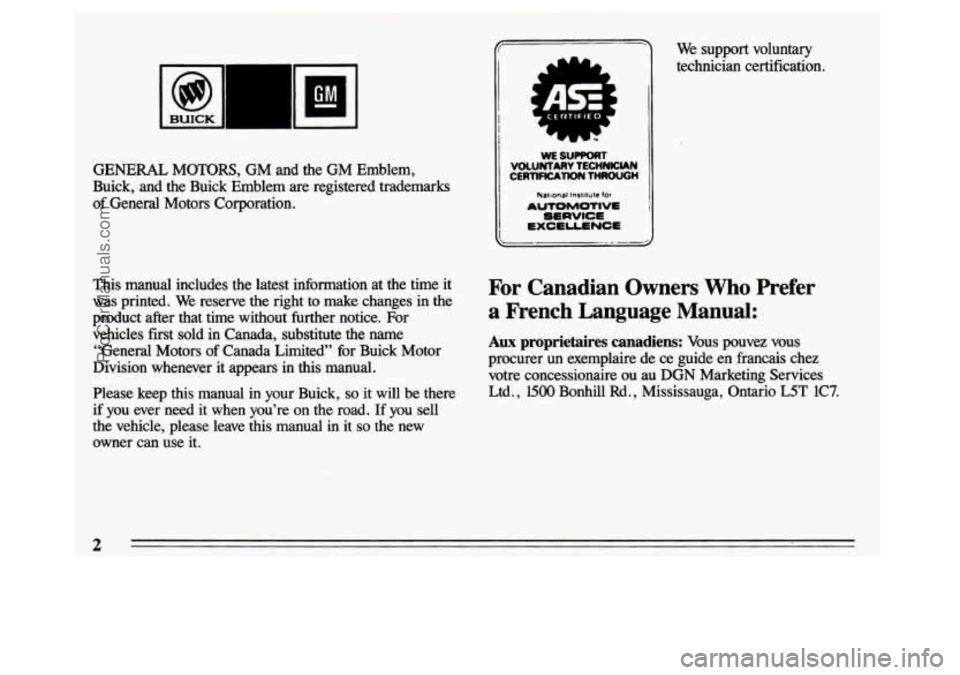
We support voluntary
technician certification.
GENERAL MOTORS, GM and the GM Emblem,
Buick, and the Buick Emblem are registered trademarks
of General Motors Corporation.
This manual includes the latest information at the time it
was printed. We reserve the right to make changes in
the
product after that time without further notice. For
vehicles first sold in Canada, substitute the name
“General Motors
of Canada Limited” for Buick Motor
Division whenever it appears in this manual.
Please keep this manual in your. Buick,
so it will be there
if
you ever need it when you’re on the road. If you sell
the vehicle, please leave this manual in it
so the new
owner can use it.
WE SUPPORT VOLUNTARY TECHNICIAN
CERTIFlCAllON THROUGH
Natlonal Insttlute for
AUTOMOTIVE ’ SERVICE i
EXCELLENCE
c .. . - __x .
For Canadian Owners Who Prefer
a French Language Manual:
Aux proprietaires canadiens: Vous pouvez vous
procurer un exemplaire de ce guide en francais chez
votre concessionaire
ou au DGN Marketing Services
Ltd.,
1500 Bonhill Rd., Mississauga, Ontario L5T 1C7.
I
2
ProCarManuals.com
Page 69 of 324

Should interference to this system occur, try this:
Check to determine if battery replacement is necessary. See
the instructions on battery replacement later in this section.
Check the distance. You may be too far from your
vehicle. This product has
a maximum range.
Check the location. Other vehicles or objects may be
blocking the signal.
See your Buick dealer or a qualified technician for
service.
Changes or modifications to this system by other than an
authorized service facility could void authorization to use
this equipment.
Operation
The driver’s door will unlock and the interior lights will
go on when “UNLOCK’ is pressed. If pressed again
within five seconds, all doors will unlock. The interior
lights will
go out after 40 seconds or when you turn on
the ignition.
All doors will lock when “DOOR” is pressed.
The trunk or liftgate will unlock when the opened trunk
symbol is pressed, but only when the transaxle is in
“P”
(Park). On the wagon the ignition must also be in the
“Off” position.
Matching Transmitter(s) to Your Vehicle
Each key chain transmitter is coded to prevent another
transmitter from unlocking your vehicle.
If a transmitter
is lost or stolen, a replacement can be purchased through
your dealer. Remember to bring the remaining
transmitter with you when you
go to your dealer. When
the dealer matches the replacement transmitter to your
vehicle, the remaining transmitter must also be matched. Once the new transmitter is coded, the lost transmitter
will not unlock your vehicle.
You can match a transmitter to as many different vehicles
as you own, provided they are equipped with
exactly the
same model system.
(General Motors offers several
different models of these systems on their vehicles.) Each
vehicle can have only two transmitters matched to it. See
your dealer to match transmitters to another vehicle.
Battery Replacement
Under normal use, the batteries in your key chain
transmitter should last about
two years.
You can tell the batteries are weak if the transmitter won’t
work at the normal range in any location.
If you have to
get
close to your vehicle before the transmitter works, it’s
probably time to change the batteries.
ProCarManuals.com
Page 98 of 324

Headlight “On” Warning
If you open the door while leaving the lights on, you will
hear a warning chime.
Daytime Running Lights (Canada Only)
The Canadian Federal Government has decided that “Daytime Running Lights” (DRL)
are a useful feature, in
that DIU can make your vehicle more visible to
pedestrians and other drivers during daylight hours. DRL
are required on new vehicles sold in Canada.
Your DRL work with a light sensor on top
of the
instrument panel. Don’t cover it up. The low beam
headlights will come on at reduced brightness
in daylight
when:
The ignition is on
The headlight switch is off, and
The parking brake is released.
At dusk, the exterior. lights will come bn &.nomatically
and the low
beams will change to full brightness. At
dawn, the exterior lights will go out and the low beams
will change to
the reduced brightness of DRL (if the
headlight switch is off).
Of course, you may still turn on the headlights any time
you need to.
To idle your vehicle with DRL off, set the parking brake
while the ignition is in the
“Off’ or “Lock” position.
Then start the vehicle. The
DRL will stay off until you
release the parking brake.
Map Light
& Press the switch to turn the
map light on and
off.
MAP
ON
OFF
96
ProCarManuals.com
Page 116 of 324
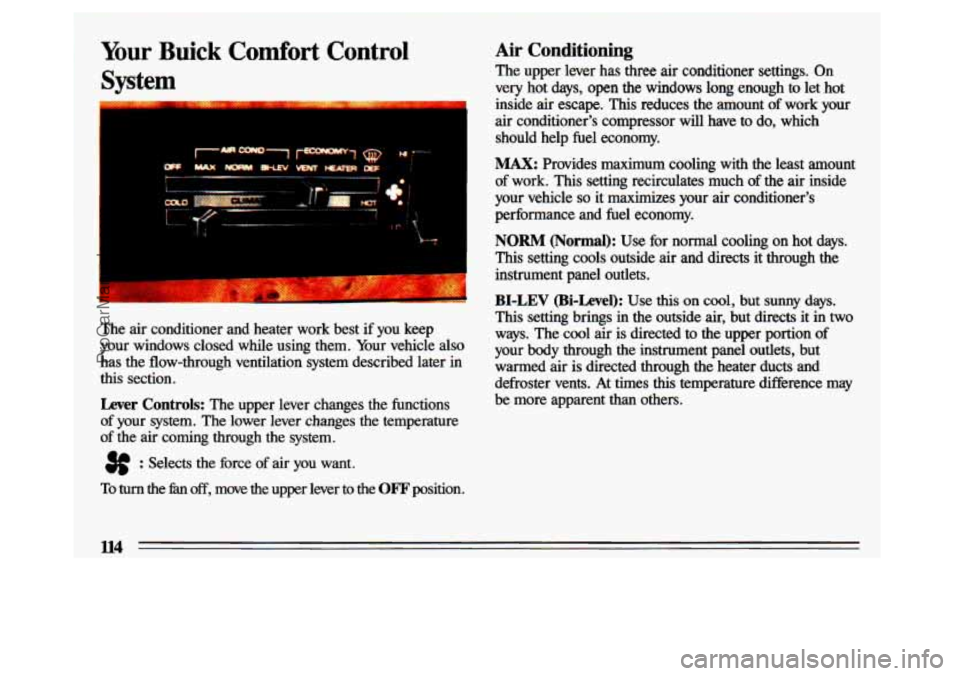
1
Your Buick Comfort Control
Syst m -
The air conditioner and heater work best if you keep
your windows closed while using them. Your vehicle
also
has the flow-through ventilation system described later in
this section.
Lever Controls: The upper lever changes the functions
of your system. The lower lever changes the temperature
of the air coming through the system.
3f : Selects the force of air you want.
Air Conditioning
The upper lever has three air conditioner settings. On
very hot days, open the windows long enough to let hot
inside air escape.
This reduces the amount of work your
air conditioner's compressor
will have to do, which
should help fuel economy.
MAX: Provides maximum cooling with the least amount
of work. This setting recirculates much of the air inside
your vehicle
so it maximizes your air conditioner's
performance and
fuel economy.
NORM (Normal): Use for normal cooling on hot days.
This setting cools outside air and directs it through the
instrument panel outlets.
BI-LEV (Bi-Level): Use this on cool, but sunny days.
This setting brings in the outside air, but directs it in two\
ways. The cool air
is directed to the upper portion of
your body through the instrument panel
outlets, but
warmed air is directed through the heater ducts and
defroster vents. At times
this temperature difference may
be more apparent than others.
To turn the 5x1 off, move the upper lever to the OF'F position.
ll4
ProCarManuals.com
Page 120 of 324
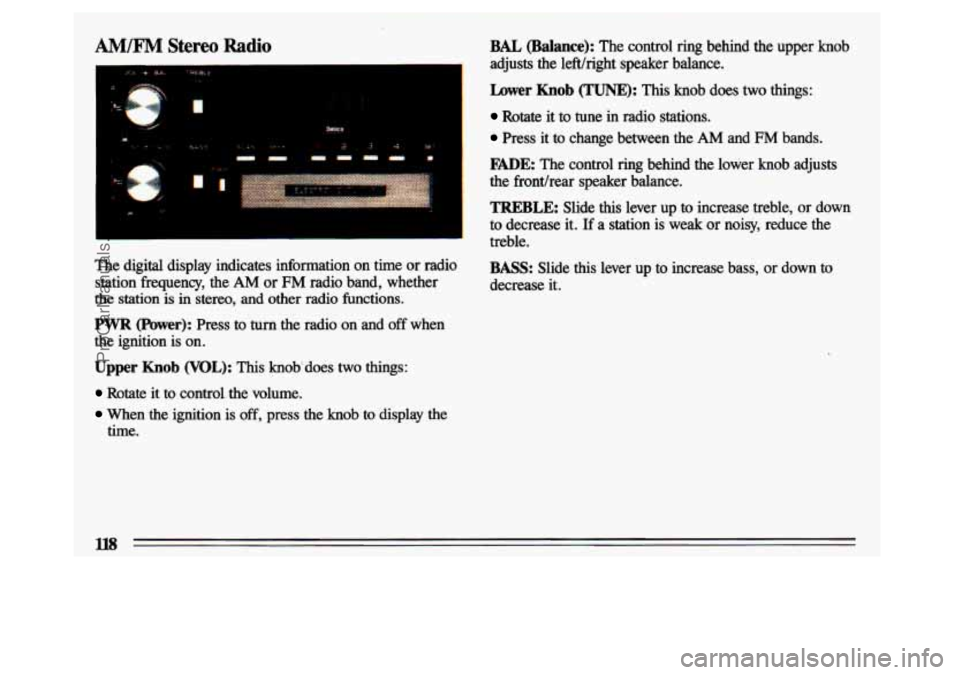
AM/F" Stereo Radio
r
J
The digital display indicates information on time or radio station frequency,
the AM or FM radio band, whether
the station is
in stereo, and other radio functions.
PWR (Power): Press to turn the radio on and off when
the ignition is on.
Upper Knob (VOL): This knob'does two things:
Rotate it to control the volume.
When the ignition is off, press the knob to display the
time.
BAL @dance): The control ring behind the upper knob
adjusts the lewright speaker balance.
Lower Knob (TUNE): This knob does two things:
Rotate it to tune in radio stations.
Press it to change between the AM and FM bands.
FADE: The control ring behind the lower knob adjusts
the front/rear speaker balance.
TREBLE: Slide this lever up to increase treble, or down
to decrease it.
If a station is weak or noisy, reduce the
treble.
BASS: Slide this lever up to increase bass, or down to
decrease it.
ProCarManuals.com
Page 122 of 324

AM/F" Stereo Radio with Cassette Player
L,
The digital display indicates information on time or radio station frequency, the
AM or FM radio band, whether
the station is in stereo, and
other radio functions.
PWR (Power): Press to turn the unit on and off when the
ignition is on.
Upper Knob (VOL): This knob does three things:
Rotate it to control the volume.
When the ignition is off, press the knob to display the time.
When a tape is playing, press the knob to hear the other
side
of the tape.
BAL (Balance): The control ring behind the upper knob
adjusts the 1eWright speaker balance.
hwer Knob (TUNE): This knob does two things:
Rotate it to tune-in radio stations.
Press it to change between the AM and FM bands.
FmE: The control ring behind the lower knob adjusts
the fronthear speaker balance.
TREBLE: Slide this lever up to increase treble, or down
to decrease it.
If a station is weak or noisy, reduce the treble.
BASS: Slide this lever up to increase bass, or down to
decrease it.
SCAN: Press to listen for a few seconds to the next
station on the
AM or FM band; the scan will continue
every few seconds until
you press SCAN again to stop on
a particular station.
SEEK Each time you press SEEK, you will tune in the
next station on the AM or FM radio band.
120
ProCarManuals.com
Page 125 of 324

AM/F” Stereo with Compact Disc Player Balance: The control ring behind the upper knob adjusts
I the lefthight speaker balance.
The digital display indicates information on time or radio station frequency, the AM or FM radio band, whether
the station is in stereo, and other radio functions.
PWR (Power): Turns the unit on and off when the
ignition is on.
Lower Knob (TUNE): This knob does two things:
Rotate it slightly to the left or right to tune in radio
stations. If you hold it to the left or right, it will tune
rapidly.
Press to change between the AM and FM bands. The
band you select will appear on the digital display.
Fade: The control ring behind the lower knob adjusts the
fronthear speaker balance.
4SEEKb: Press to seek and stop on the next station
higher or lower on the radio band.
SCAN: Press this button to listen to stations for a few
seconds. Press it again to stop scanning.
Upper Knob (VOL): This knob does two things:
Rotate it slightly to the left or right to control the volume\
.
Press it to mute the radio or tape player. Press again to
listen.
ProCarManuals.com
Page 143 of 324
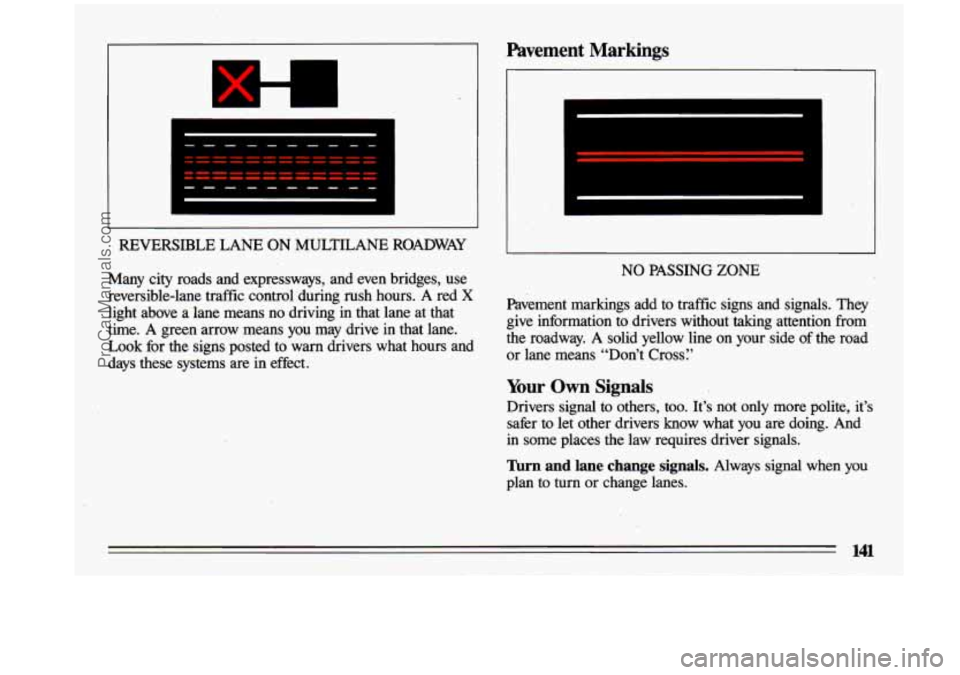
x
I I
REVERSIBLE LANE ON MULTILANE ROADWAY
Many city roads and expressways, and even bridges, use
reversible-lane traffic control during rush hours. A red
X
light above a lane means no driving in that lane at that
time. A green arrow means you may drive in that lane.
Look for the signs posted to warn drivers what hours and
days these systems are in effect.
Pavement Markings
NO PASSING ZONE
Pavement markings add to traffic signs and signals. They
give information to drivers without taking attention from
the roadway. A solid yellow line on your side
of the road
or lane means “Don’t Cross:’
Your Own Signals
Drivers signal to others, too. It’s not only more polite, it’s
safer to let other drivers know what you are doing. And
in some places the law requires driver signals.
Turn and lane change signals. Always signal when you
plan to turn or change lanes.
141
ProCarManuals.com
Page 155 of 324

So here are some tips for passing:
“Drive ahead:’ Look down the road, to the sides, and
to crossroads for situations that might affect your
passing patterns. If you have any doubt whatsoever
about making a successful pass, wait for a better time.
Watch for traffic signs, pavement markings, and lines.
If you can
see a sign up ahead that might indicate a
turn or an intersection, delay your pass. A broken
center line usually indicates it’s
all right to pass
(providing the road ‘ahead is clear). Never cross a solid \
line on your side of the lane or a double solid line, even
if the road seems empty of approaching traffic.
If you suspect that the driver of the vehicle you want to
pass isn’t aware of your presence, tap the horn a couple
of times before passing.
Do not get too close to the vehicle you want to pass
while you’re awaiting
an opportunity. For one thing,
following too closely reduces your area
of vision,
especially if you’re following a larger vehicle. Also,
you won’t have adequate space if the vehicle ahead
suddenly slows or stops. Keep back a reasonable
distance.
When it looks like a chance to pass is coming up, start
to accelerate but stay in the right lane and don’t get too
close. Time your move
so you will be increasing speed
as the time comes to move into the other lane. If the
way is clear to pass,
you will have a “running start’’
that more than makes up for the distance you would
lose
by dropping back. And if something happens to
cause you to cancel your pass, you need only slow
down and drop back again and wait
for another
opportunity.
If other cars are lined up to pass a slow vehicle, wait
your turn. But take care that someone isn’t trying
to
pass you as you pull out to pass the slow vehicle.
Remember to glance over your shoulder and check the
blind spot.
start your left lane change signal before moving out of
the right lane to pass. When you are far enough ahead
of the passed vehicle to see its front
in your inside
mirror, activate your right lane change signal and move
back into
the right lane. (Remember that your right
outside mirror
is convex. The vehicle you just passed
may seem to be farther away from you
than it really is.)
Try not to pass more than one vehicle at a time on two-
lane roads. Reconsider before passing the next vehicle.
Check your mirrors, glance over your shoulder, and
ProCarManuals.com
Page 167 of 324
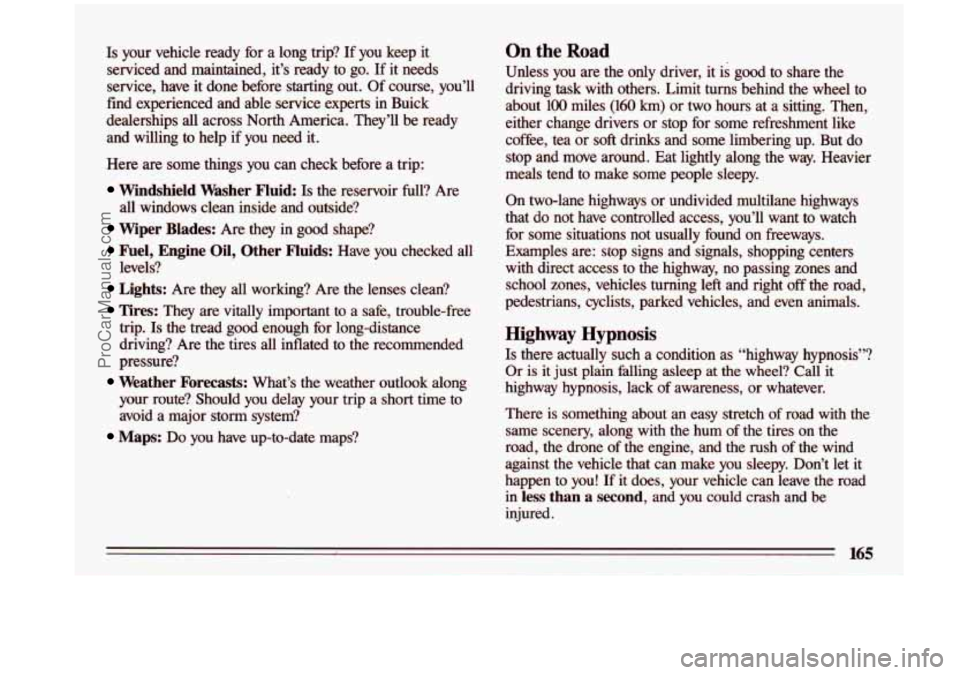
Is your vehicle ready for a long trip? If you keep it
serviced and maintained, it’s ready to go. If it needs
service, have it done before starting out.
Of course, you’ll
find experienced and able service experts in Buick
dealerships
all across North America. They’ll be ready
and willing to help if you need it.
Here are some things you can check before
a trip:
Windshield Washer Fluid: Is the reservoir full? Are
all windows clean inside and outside?
Wiper Blades: Are they in good shape?
hel, Engine Oil, Other Fluids: Have you checked all
Lights: Are they all working? Are the lenses clean?
Tires: They are vitally important to a safe, trouble-free
trip.
Is the tread good enough for long-distance
driving? Are the tires all inflated to the recommended
pressure?
Weather Forecasts: What’s the weather outlook along
your route? Should you delay your trip a short time to
avoid a major storm system?
levels?
Maps: Do you have up-to-date maps?
On the Road
Unless you
are the only driver, it is good to share the
driving task with others. Limit
turns behind the wheel to
about
100 miles (160 km) or two hours at a sitting. Then,
either change drivers or stop for some refreshment like
coffee, tea or
sol3 drinks and some limbering up. But do
stop and move around. Eat lightly along the way. Heavier
meals tend
to make some people sleepy.
On two-lane highways or undivided multilane highways
that do not have controlled access, you’ll want to watch for some situations not usually found on freeways.
Examples are: stop signs and signals, shopping centers
with direct access to the highway, no passing zones and school zones, vehicles turning left and right
off the road,
pedestrians, cyclists, parked vehicles, and even animals.
Highway Hypnosis
Is there actually such a condition as “highway hypnosis”?
Or is it just plain falling asleep at the .wheel? Call it
highway hypnosis, lack of awareness, or whatever.
There is something about an easy stretch
of road with the
same scenery, along with the hum
of the tires on the
road, the drone
of the engine, and the rush of the wind
against the vehicle that can make you sleepy. Don’t let it \
happen to you!
If it does, your vehicle can leave the road
in
less than a second, and you could crash and be
injured.
165
ProCarManuals.com